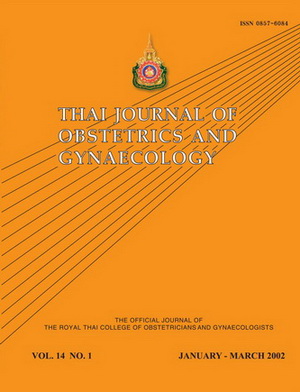A Prospective Randomized Study Comparing Voiding Time Between Suprapubic Catheterization and Intermittent Self-Catheterization Following Radical Hysterectomy and Pelvic Lymphadenectomy for Cervical Cancer
Main Article Content
Abstract
Objective To compare the voiding time between intermittent self-catheterization (ISC) and
suprapubic catheterization (SPC) in cervical cancer patients undergoing radical hysterectomy
and pelvic lymphadenectomy (RHPL).
Design Prospective randomized study.
Setting Division of Gynecologic Oncology, Department of Obstetrics & Gynecology, Faculty
of Medicine, Chiang Mai University.
Subjects & Methods Between September 1998 and June 1999, 71 patients with stage IB-IIA
cervical cancer undergoing RHPL were prospectively randomized to receive either ISC (38
cases) or SPC (33 cases) for managing post operative bladder dysfunction. Intermittent
self-catheterization every 4 hours after voiding was initiated on day 7 post-operatively in the
ISC group, whereas in the SPC group, the catheter was clamped on 7th post operative day.
The duration for clamping in the SPC group was 4 hours and was released after self voiding to
check the residual urine. Both ISC and SPC were discontinued when post voiding residual
urine was less than 75 ml for 2 consecutive voids. Patients in the SPC group were switched to
perform ISC if they could not void normally at day 30 postoperatively. The voiding time, the
frequency of urinary tract infection, perioperative data and morbidity were recorded.
Results Both groups were similar regarding age, body mass index (BMI), tumor histology,
stage, size and gross appearance of the tumors. There was no difference between groups in
respect of operative time, need for blood transfusion, perioperative morbidity, need for
adjuvant chemoradiation and the frequency of urinary tract infection. Twenty-five (65.8%)
patients in the ISC group and 23 (69.7%) in the SPC group had voiding time less than 30 days.
Mean voiding time in the ISC group was significantly less than that in the SPC group (13.1 days
vs. 17.3 days respectively, P = 0.02).
Conclusion Patients performing ISC after RHPL for invasive cervical cancer can resume bladder
function earlier than those undergoing SPC without significant difference in the frequency of
urinary tract infection and perioperative morbidity
suprapubic catheterization (SPC) in cervical cancer patients undergoing radical hysterectomy
and pelvic lymphadenectomy (RHPL).
Design Prospective randomized study.
Setting Division of Gynecologic Oncology, Department of Obstetrics & Gynecology, Faculty
of Medicine, Chiang Mai University.
Subjects & Methods Between September 1998 and June 1999, 71 patients with stage IB-IIA
cervical cancer undergoing RHPL were prospectively randomized to receive either ISC (38
cases) or SPC (33 cases) for managing post operative bladder dysfunction. Intermittent
self-catheterization every 4 hours after voiding was initiated on day 7 post-operatively in the
ISC group, whereas in the SPC group, the catheter was clamped on 7th post operative day.
The duration for clamping in the SPC group was 4 hours and was released after self voiding to
check the residual urine. Both ISC and SPC were discontinued when post voiding residual
urine was less than 75 ml for 2 consecutive voids. Patients in the SPC group were switched to
perform ISC if they could not void normally at day 30 postoperatively. The voiding time, the
frequency of urinary tract infection, perioperative data and morbidity were recorded.
Results Both groups were similar regarding age, body mass index (BMI), tumor histology,
stage, size and gross appearance of the tumors. There was no difference between groups in
respect of operative time, need for blood transfusion, perioperative morbidity, need for
adjuvant chemoradiation and the frequency of urinary tract infection. Twenty-five (65.8%)
patients in the ISC group and 23 (69.7%) in the SPC group had voiding time less than 30 days.
Mean voiding time in the ISC group was significantly less than that in the SPC group (13.1 days
vs. 17.3 days respectively, P = 0.02).
Conclusion Patients performing ISC after RHPL for invasive cervical cancer can resume bladder
function earlier than those undergoing SPC without significant difference in the frequency of
urinary tract infection and perioperative morbidity
Article Details
How to Cite
(1)
Suprasert, P.; Srisomboon, J.; Phongnarisorn, C. A Prospective Randomized Study Comparing Voiding Time Between Suprapubic Catheterization and Intermittent Self-Catheterization Following Radical Hysterectomy and Pelvic Lymphadenectomy for Cervical Cancer. Thai J Obstet Gynaecol 2017, 14, 73-80.
Section
Original Article


